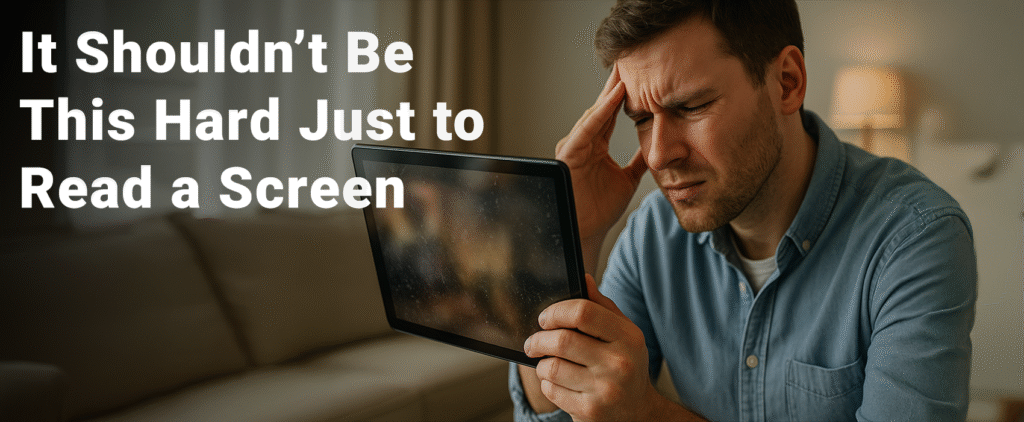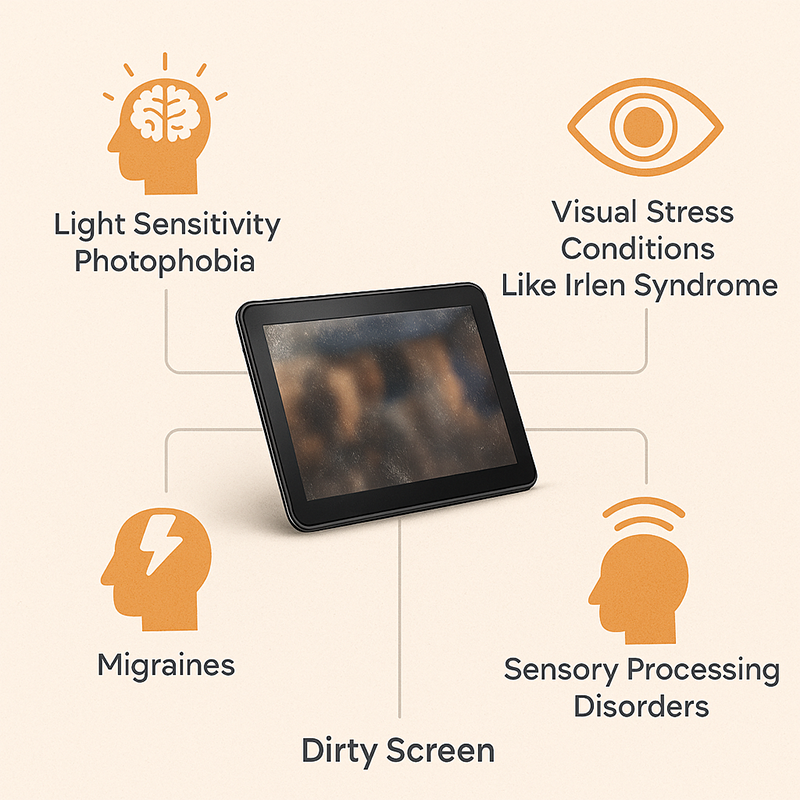
The “Digital Curb” Explained
Screen glare accessibility is often overlooked, yet it’s the silent barrier millions face every day. Imagine trying to read a book with a crumpled, greasy piece of glass held over the page. The words would blur, your eyes would strain, and your brain would fight to make sense of the chaos. That’s the daily reality for those navigating screens clouded by fingerprints, glare, and grime.
For many, a dirty screen isn’t just a minor annoyance — it’s a real barrier. This “Digital Curb” prevents comfortable access to devices, just like a missing wheelchair ramp can prevent access to a building.
It’s especially challenging for people with:
- Photophobia – Light sensitivity can turn scattered reflections into physical pain and migraines.
- Irlen Syndrome or visual stress – Glare can distort text, making reading exhausting.
- Sensory Processing Disorders – Often experienced in autism, micro-glare and reflections can lead to overwhelm or anxiety.
- Migraine sufferers – Even brief exposure to intense screen glare can trigger severe symptoms.
What looks like “just a few smudges” to some can feel like a wall to others.
Expert Insights: The Importance of Reducing Visual “Noise”

Accessibility specialists and occupational therapists consistently emphasize this: visual clutter matters. Reducing distractions on screens—whether from cluttered interfaces or smudged surfaces—is critical for digital wellness and inclusive design.
While many expert reports emphasize digital design elements like layout and motion, the same principles apply to physical screen conditions. When screens are covered in glare and grime, they create chaotic reflections—what experts call “visual noise.” This disrupts screen glare accessibility, making it harder for users, especially those with visual sensitivities, to engage comfortably and effectively
Why does this matter?
- It increases cognitive load, especially for neurodiverse users who process visual information differently.
- It makes it harder to concentrate, especially for those with sensory sensitivities.
- It disrupts the calm, clear environment recommended by therapists for managing anxiety, focus, and visual processing challenges.
Just as we clean our workspaces to reduce distractions, cleaning our screens helps users—especially those with conditions like autism or ADHD—interact with digital tools more calmly and confidently.
The Science of Light: How Smudges Create Micro-Glare
A screen isn’t just a display—it’s a precision surface meant to deliver clean, uninterrupted visuals. But when fingerprints, dust, and oil accumulate, they scatter light in unpredictable ways. This scattered light creates glare, which directly interferes with screen glare accessibility, especially for users with visual sensitivities or neurodiverse needs.
According to experts at Specsavers UK, glare reflected from screens—especially from light-coloured walls or glossy surfaces—can significantly contribute to eye strain, blurred vision, and fatigue. Minimizing glare and improving screen accessibility can dramatically enhance visual comfort and focus, particularly during extended use of digital devices, as outlined in the article Digital Devices and Your Eyes by the American Academy of Ophthalmology.
🔬 What Actually Happens on a Dirty Screen:
- Light Scattering: Instead of light traveling directly from the screen to your eyes, it hits smudges and particles, bouncing off at different angles.
- Visual Distortion: This causes “micro-glare”—tiny bursts of brightness that blur images, dull text, and introduce haze.
- Cognitive Fatigue: Your brain works harder to decode what’s on the screen, even if you don’t consciously notice it.
👁️ Why It Matters:
- Eye Strain: Prolonged exposure to screen glare leads to dryness, irritation, and blurred vision.
- Reduced Focus: Your brain is constantly adjusting to process degraded visuals, leading to faster mental fatigue.
- Sensory Overload: For neurodivergent individuals, this chaotic visual input can trigger anxiety or cognitive shutdown.
👉 Clean screens aren’t just about aesthetics—they reduce light chaos, protect your focus, and preserve your comfort.
Clarity for All: Remove the “Digital Curb”
A clean screen may seem like a small detail—but for many, it changes everything.
The smudges you overlook could be the very barrier stopping someone from reading, focusing, or navigating digital spaces comfortably. Clareex removes these subtle yet disruptive layers—not just to make screens sparkle, but to improve screen glare accessibility, making every display more calming, welcoming, and inclusive for everyone.
Whether you’re living with sensory sensitivity, supporting someone who is, or just want a clearer, easier digital experience—Clareex is your everyday ally.
- ✅ Gentle and safe for all screens
- ✅ No harsh chemicals
- ✅ Designed for comfort, tested for trust
👉 Let’s wipe away the barriers. Try Clareex today—and bring digital clarity to everyone.
